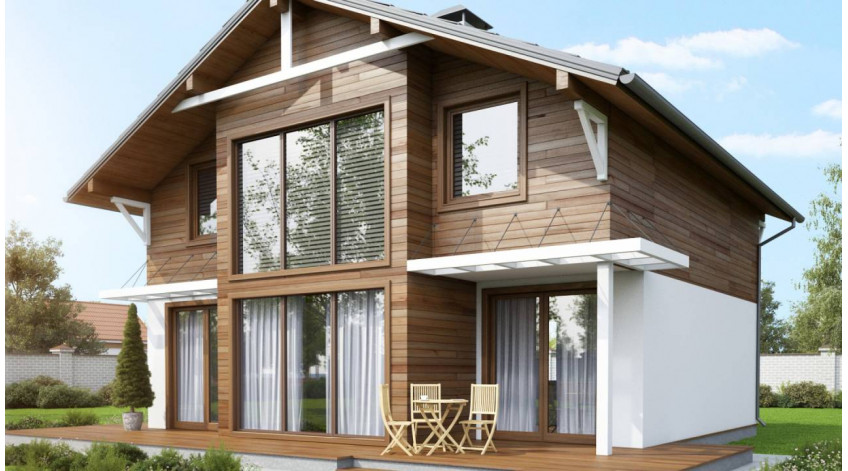Houses from SIP panels: advantages and disadvantages

The time when we could heat our house for a long time is already behind us. Energy is becoming more expensive, and there is a need for energy-saving technologies. Nowadays, there is a great variety of them, which also includes recuperation systems, and heat pumps, and houses that do not need to be heated (passive).
The turn-key house is a modern service that is becoming more popular today. But when planning its construction, do not forget that this process will not end simply by construction. The erected house will require additional attention in the content. The main issue is the equipment of the heating system. After all, if you do not take into account this during construction, it will be much more difficult and expensive to heat a finished structure.
It is impossible to erect a wooden or brick house at once warm. After the construction it is necessary to be insulated. Is this process effective? Yes, the insulation will pay off in the first 2-3 years. Even if you decide to build a so-called "warm" house from glued beams, it will still have to be insulated. "Warm" it only compared to brick houses.
Also, it is worth considering that a separate house will be cooler than an apartment, because in it all the walls are external. The floor and ceiling will also be cold.
The most durable are the brick walls. In addition, they are environmentally friendly and fire-resistant. If we talk about a warmed stone wall, there are three important points:
- high price;
- complexity of equipment;
- risk in operation.
There is a number of complications for the insulation of buildings. It is necessary that materials for insulation are environmentally friendly, repair after this process costs a lot of money, there is a risk of fire of the room. You can not think about all this if you are engaged in individual construction. In this case, you will not simply avoid unnecessary costs, but will also save money.
Why are there problems during the operation of insulated houses?
When warming, a multi-layer construction is created. It is important that there are no gaps between the wall, the insulation layer and the finishing layer. If they are, they get air, moisture accumulates, mold appears. Heat-shielding layers are amenable to destruction, often in consequence of this the wall itself is destroyed.
If the air gap is present, it must be ventilated.
The construction of the Canadian house involves the use of SIP-panels, which are still in the factory lend themselves to gluing under the press. As a result of air gaps, they do not. Another advantage is that SIP panels do not need steam and wind insulation. Accordingly, the problems that arise when equipping multilayer structures are not characteristic of them. These panels do not conduct heat, so houses from sip are the most energy efficient. They retain heat 1.5 times better than frame, insulated with mineral wool. Than it is caused?
SIP panels are made of expanded polystyrene. It is more effective than mineral wool.
The thermal properties of the frame walls decrease over time due to shrinkage of the house, and the mineral wool lends itself to moistening.
The installation of frame walls may cause defects.
In America, installation defects are considered even such trifles as a heater with a rounded edge or its compression around the wiring, which our masters do not even pay attention to.
For a brick wall to retain heat in the same way as a SIP panel, it should be about 15 times thicker than SIP.
The energy-saving properties of SIP panels are considered unique. They passed the frost test -50 ° C at the South Pole.
SIP homes can be heated by electric heaters. To install them do not need huge costs, especially when compared to gas, liquid or warm fuel. In order for houses from sip panels to be well heated by electricity, the power is much less than 1 kW / 10m2, to which we are accustomed. To ensure that in the cold season in your house from sip will be warm, you can equip a fireplace or stove.
The walls of Canadian houses "resist" heat, because of this their thermal conductivity is very low, and energy-saving properties are high. The heat that has accumulated in the room will maintain the normal temperature for a long time. Even in severe frosts, when the heating is turned off, the temperature will drop just a few degrees per day.
In the hot summer days in the house of the sip-panels, too, is comfortable. If the Canadian house does not "release" the heat in the winter, on the contrary in the summer - "does not let in". Houses from sip are perfect for permanent residence.
Fire safety
This property, which lasts forever the disputes between supporters of houses made of bricks and wood. Many materials for construction are flammable, but even if your house is built of material that is not capable of catching fire, you are still not protected from the fire. After all, the flame does not cover the walls, but the things that are inside the room. First of all, furniture, carpets and interior decoration are on fire. It is they who spread fire around the house and are the source of poisoning of people who are inside.
The only advantage of a brick house is that after a fire it will leave walls, which will not happen if your house is made of wood. But not the fact that the house can be restored, because most of the walls of brick lose their strength due to the effects of fire. So, most often, after a fire, such a house is simply demolished.
Even if it was possible to save the brick walls, finishing inside and outside the house, as well as engineering networks, the ceilings from the tree and the roof must be done again. In addition, the smell of smoke remains in the walls forever. Therefore, in such cases, specialists almost always recommend to demolish everything and build a new house.
How to increase the fire safety at home
In the construction there are a number of rules, adhering to which you can reduce the risk of fire of your home:
- use of fire retardant paints and compounds;
- compliance with the rules for electrical wiring;
- compliance with the requirements of the device furnaces and fireplaces;
- compliance with fire regulations during construction;
- adherence to the general rules of fire safety.
The fulfillment of these points is much more important than the material for erecting the house. Most often, a fire arises from neglect of these rules. How high is the fire hazard of your house, does not depend on the walls, but on you as the owner.
The construction of Canadian homes should start from the selection of quality sip panels. Therefore, if you decide to build just such a house, be attentive to the properties of expanded polystyrene, from which they are produced. Cheap sip-panels are made of bad materials, respectively.
What is polystyrene foam?
The main component of styrofoam is styrene. It is a substance that is found in many natural things. The resin of trees in ancient times was used for perfumes and medicines, because it has aromatic properties.
Nowadays it is used in the field of medicine as an antiseptic, for inhalation, for the creation of spirits and soap. This resin is called styrax. It is isolated by the trees in case of damage. Usually, sturax is found in the bark. A pleasant smell of this resin gives exactly styrene. So he called the German pharmacist Edward Simon, when isolated in its pure form as a liquid. A few days later he noticed that styrene had become denser. So there was polystyrene.
Polymeric materials of a nature nature have been used for a long time. This cotton, wool, leather, fur, etc.
The use of polystyrene at the industrial level began in the twentieth century. Since then, it occupies an important place in our life. We use disposable utensils, food storage trays, toys and other products that contain polystyrene.
Polystyrene itself is harmless, but under certain conditions it can release styrene. And it is considered though weak, but toxic. Large amounts of styrene can irritate the mucous membranes of the upper respiratory tract, cause a headache, affect the activity of the nervous system. But in small doses of styrene does not cause harm to health. We use it in the composition of grapes, nuts, strawberries. And the view that styrene accumulates in the body is erroneous.
Styrofoam is made from polystyrene. Developed countries give it preference, as the most environmentally friendly material, and in Japan it is advised to live in houses from sip for better health. Most residents of Europe are warming their homes with expanded polystyrene.
Features of houses from sip
When building any house, it is worth considering such characteristics:
- strength;
- noise insulation;
- ventilation.
As a construction in general, the Canadian house is very durable. He will sustainly endure earthquakes and hurricanes, but he will not protect himself from bullets and shrapnel.
Living in a noisy city street, I want the house to have good noise insulation qualities. The sip panels are very thin, but isolated from the noise perfectly. So, if you are planning to build your own home in the city, choose Canadian technology.
The Canadian home needs good ventilation, because its walls are airtight. In such houses, the ventilation process is controlled by the owners. Rooms where people permanently reside must often be ventilated.
How green are the houses from sip?
On the Internet you can find a lot of information that sip panels are harmful to health. But these are just myths. On the construction market of Ukraine all products come from North America and Europe. It is in these countries that the requirements for environmental safety of materials for construction are very high. The presence of formaldehydes is checked by special devices a few months after the production of the panels. The environmentally friendly slab makes it possible to make use of natural resins, fillers and hardeners.
Another advantage of houses from sip - they do not live in rodents. Many waving their hands at this fact and do not take it into account when choosing materials for building a house, and then the appearance of such "living creature" brings trouble. So, in the US and Canada, sip panels are built not only residential buildings, but also premises for warehouses and shops. Over many years of experience it has been proved that the above-mentioned pests in such premises do not live. Why? Because styrofoam for them is inedible.
There is also a myth that in the West, Canadian homes are dwellings for the homeless and the poor. But this is far from the case. This proves the local Internet resources on this topic. SIP technologies in Western countries are not cheap. They are positioned as a technology of green building and energy saving. SIP panels are used here for the construction of ordinary garden houses, as well as for office buildings and even for locks. Almost all of them have luxurious finishes and high-quality technical equipment.
In our time, the Canadian technology of erecting houses is becoming more popular. It has no competitors, especially for those who plan to build dwellings on their own.
If you are the one who is looking for rational ways of investing money and time - building houses from sip for you. This is financially affordable option and warmer than brick. Choose the construction of houses by the Canadian method, because the future is for energy-efficient technologies.
 Русский
Русский English
English Українська
Українська



